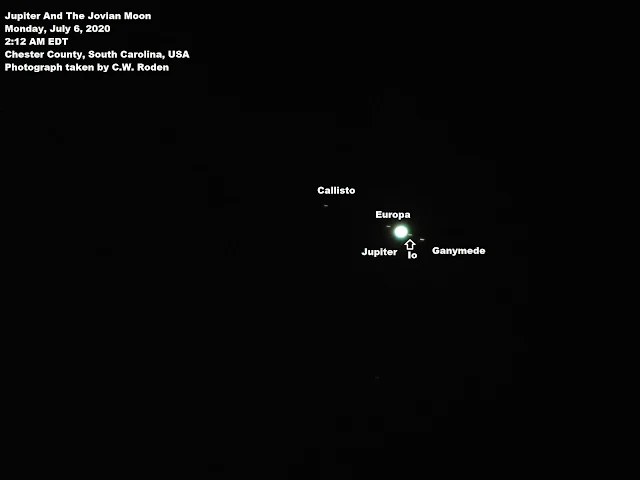Good evening, fellow stargazers!
Last night I was able to capture our beautiful full moon in the southern sky in a celestial triangle with the two largest planets on our solar system: Jupiter and Saturn.
Last night I was able to capture our beautiful full moon in the southern sky in a celestial triangle with the two largest planets on our solar system: Jupiter and Saturn.
As you can see Luna appears to be topped by the two planets. Bright Jupiter can be seen on the right, while Saturn appears a bit smaller and about one-third dimmer on the left.
A closeup shot of Jupiter I took once again reveals all four of the famous Galilean satellites that famed Italian astronomer Galileo Galilei discovered using his first crude telescope 410 years ago. Io and Ganymede appear on one side of Jupiter, while Europa and Callisto (more widely separated) can be seen on the other. They are the four largest of Jupiter's 79 known moons.
 |
| The four Galilean (Jovian) Moons: (from top to bottom) Io, Europa, Ganymede, and Callisto -- compared by size next to the Great Red Spot of Jupiter. |
Unfortunately, even at maximum magnification, my camera can't pick up the rings, but if you are checking out Saturn, any telescope magnifying more than 25-power should provide you with a view of its famous ring system, now tilted nearly 22 degrees toward Earth.
Anyone wanting to see the two large planets will still be able to for some time as they will remain close to each other in the late evening sky for much of the rest of the year. Jupiter and Saturn will continue to get brighter heading into the middle of the month with the two planets making their closest approach (opposition) to the Earth in mid-July -- Jupiter on the evening of Monday, July 13th and Saturn on Monday, July 20th. The moon will meet them again in the evening sky on Saturday, August 1st.
My final shot is a close up of the full moon.
Luna actually became a full moon in the early morning hours of July 5th. In North America the July full moon is called the Buck Moon because this is the time of year that male deer begin to grow velvety antlers. Farmers call the July full moon a Hay Moon, or Thunder Moon because farmers are working to put hay in their barns and trying to avoid the frequent summer thunder showers.
Well folks, I hope y'all have a wonderful evening and remember to keep your eyes to the night skies!



No comments:
Post a Comment